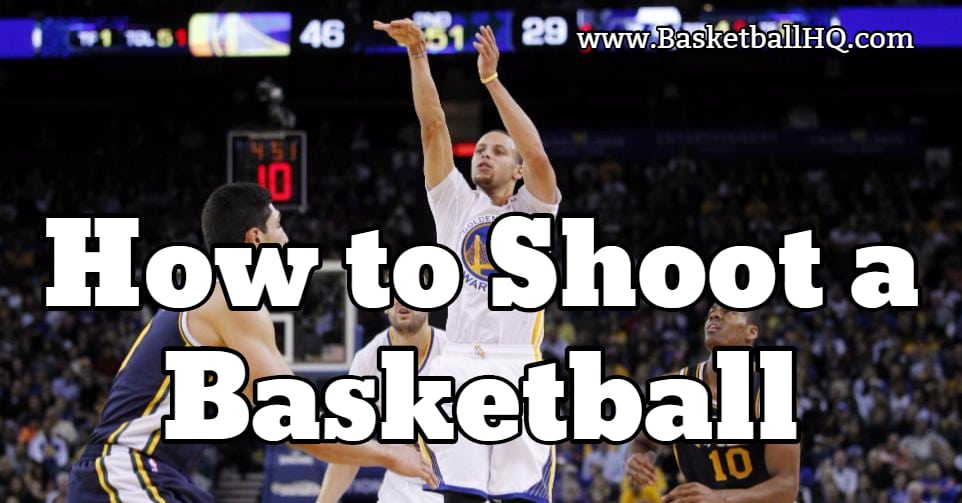
There are many great shooters in the game of basketball, and most of them have different variations in the way they shoot the basketball. Some may jump a little higher, shoot it more centered in their body, step 1-2, or hop into their shot, etc. My point is that there is no one exact way to shoot a basketball.
That being said, there are absolutely details that will increase or decrease your shooting percentage as a basketball player. Great shooters have different variations in the way they shoot the basketball, but they all have mastered the details of what goes into a great shot, and that is what we are going to focus on.
Practice Makes Perfect…or Does It?
We have all heard the phrase, “practice makes perfect,” and it sounds like a good saying at first. Unfortunately, though, it is not true. A more accurate saying would be, “practice makes permanent.” This means that if you have bad habits in your basketball shooting form and continue to do basketball shooting drills without correcting them, you will not perfect your shot but instead ingrain those bad habits even further into your shot.
This is why it is important to make sure you are shooting the basketball with the correct form and fundamentals. After you have this, then you can start to work on developing muscle memory. “Perfect practice makes perfect.”
The Details of How to Shoot a Basketball
When evaluating a basketball player’s shot, I like to use the idea of a plus/minus scoring system. Every good habit that a shooter has is a plus, and every bad habit is obviously a minus. The same thing goes with shooting percentages. For example, if a shooter doesn’t get squared up before the shot, stay balanced, doesn’t hold their follow-through, etc., it all adds up and takes away from the chances of the shot going in.
On the other hand, if the player is mentally engaged and focuses on all the details that go into being a great shooter, their shooting percentage will increase. Great shooters have spent time working on the details of shooting a basketball, and they are now using muscle memory for them.
Here is a breakdown of the shooting details that you should be focusing on.
Shot Preparation
- Show hands and be down ready for your shot before the ball comes to you.
- Consistency in coming into your shot.
- Whether you hop or 1-2 into your shot, it should be the same way every time.
- Great footwork and balance before EVERY shot will really help to improve the quality of the shot.
Shooting the Ball
- Load the basketball in the shooting pocket.
- Your wrist should be cocked back before the ball gets there.
- Bring the basketball up your body in a straight line.
- This will allow you to keep your arm under the ball and give you the power behind your shot.
- Execute the shot in one smooth motion.
- Don’t pause on the way up.
- The smoother your shot is, the better range you will have.
- Use your legs to generate power in your shot.
- You shouldn’t feel like you have to push with your arms.
Finishing Your Shot
- Land in the same area or slightly forward as you jumped from (unless purposely fading away to get your shot off).
- Hold your follow-through until you make or miss, don’t pull your follow-through or let your hand drift off to the side.
- Try to land on both feet at the same time.
- Don’t kick one leg out as you land; be balanced.
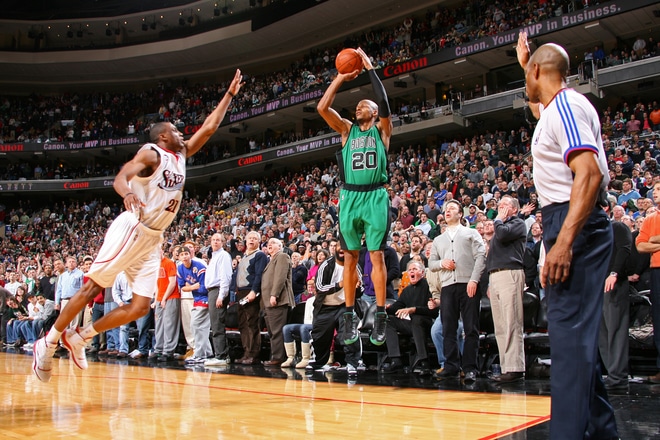
Being Down Ready on Your Basketball Shot
What is being down ready on your basketball shot? Down and ready is what is done in preparation for your shot. What you want to do is have your feet set, drop your butt, place your hands where you want to receive the pass, and be ready to jump or step into your shot simultaneously as the pass is received. This allows you to go right into your shot as soon as the basketball reaches your hands.
Why be Down Ready as a Shooter?
Why is it so important to be down ready? Let’s look at some of the positives of being in a down ready position:
- Being down ready not only allows you to shoot a higher percentage, but it also allows you to get your shot off quicker.
- When you practice being down ready on the catch, you will establish the same kind of reps when you shoot. This is important because if you have practiced your shot the same way repeatedly, you will shoot a much higher percentage when it comes time to shoot in the game.
- Being down ready avoids telegraphing to defenders that a shot is about to be taken as the player guarding you always sees an offensive player in a ready to shoot/ready to move stance.
There are certainly other positives to being in a down ready basketball shooting stance, but the three reasons given above should be enough to persuade any basketball coach or player of its importance.
The Negatives of NOT Being Down Ready
The negatives of not being down ready are pretty much the opposite of the positives. It takes a much longer time to catch the ball standing straight up and then load your shot. This wasted time allows your defender to close you out and better contest your shot, and this delay might even take away your shot opportunity. This will also drastically lower your shooting percentage because you are taking a different approach to your shot every time you catch the ball.
Coaching Muscle Memory
Being a great shooter in basketball has a lot to do with muscle memory, so it is important to take the same approach to each shot. This is a skill that any shooter can add to their game without very much effort. All it takes is the conscious effort to focus on being down ready until it becomes a habit.
As a coach, you can help your players by reminding them as they are getting balls for shots up or in practice so that they perform the habit without a thought in the game.
As you begin to play and coach at higher levels of competition, this will become an even more important skill to add to your game. It will be almost a necessity. Watch this quick video on basketball shot preparation to better understand what being down ready looks like. After that, when you work on your shooting with different basketball drills, make sure to lock in on being down ready on every shot.
6 Ways to Improve Your Shooting: Without Changing Your Mechanics
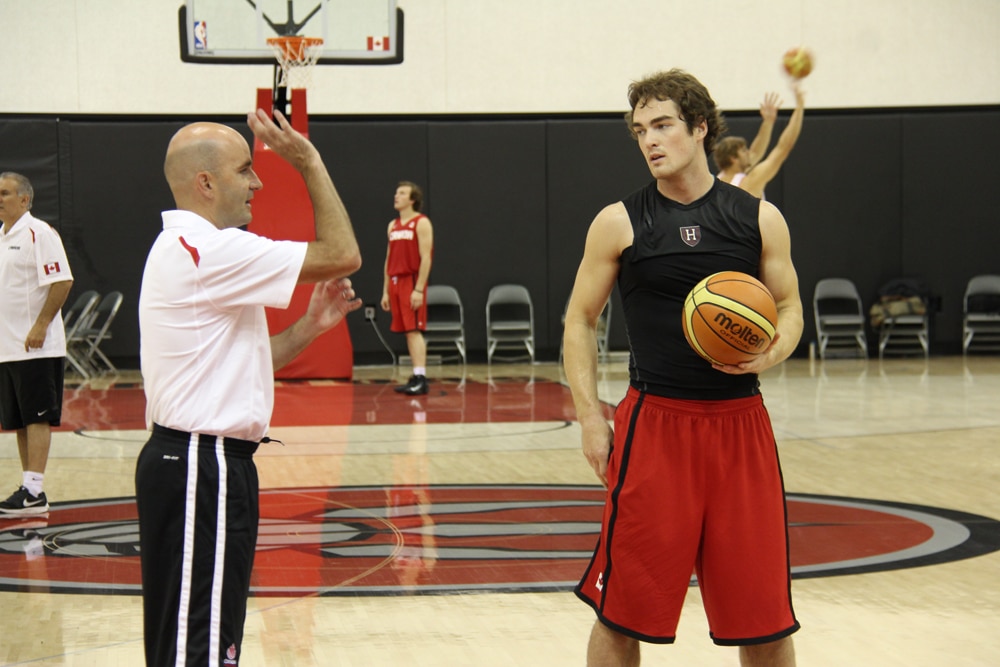
Dave Love contributed to this portion of the article.
Let me start by saying that I do believe in changing mechanics. I feel like it is easy to fall into the idea that “old dogs can’t learn new tricks” or “if it ain’t broke, don’t fix it.” As I watch shooters, there is usually a physical reason for why they miss the shots they do, and I believe that if you can fix the physical flaw, the results will improve.
With that being said, I also believe there are circumstances where or when a player should not make major changes to their shot.
- If you are already an outstanding shooter
- If you are entering into a time of year with the most critical games
- If you are not able to be consistently held accountable.
Let us talk about that last one for a second. I get players all the time that come into my life, and I believe they need to make significant fundamental changes. Maybe they sign a ten-day contract, or maybe they are at a predraft workout. They are weak shooters, and I can see why, but the problem is I am not going to have the time to help them build the new habit.
So I have to bite my tongue and hope they find someone in their life that will give the consistent time needed, or that we end up in the same place long enough to do it ourselves. I do not want to start a two-month process with someone I can only support for one day.
But let us focus on little things that any player can do to improve some, without making significant fundamental changes that may be needed.
6 Ways to Improve as a Shooter in Basketball:
Warm-Up For Everything When You Shoot
This is so simple, yet I rarely see anyone do it. Do you have a practice? Individual workout? Game? Tryout? Get in the gym 10 minutes before it starts and warm up your shot. Get 25 form shots from close to the hoop. Have good balance, get to the bottom of the ball, get your non-shooting hand off the ball, follow through well.
Then get five catch-and-shoot shots from 5 spots on the floor, staying close to the hoop, then back out a couple of steps and get 25 more. Then practice a little faster and more game situations with cuts, pivots, and jab scoring moves. If you have time, think of 2 situations that you know you will get shots from and practice those. Shoot some free throws.
If you do not have time for all this, no problem, just cut everything in half or less. But do not bury your head in the sand and come into situations unprepared—even practice. You may think you do not need to warm up for practice, but your coach will be forming opinions of you, and if you are missing shots early in practice because you are not loose or feeling right, their opinion will be that you are not a good shooter.
Land on Two Feet After You Shoot the Ball
It is a natural impulse for players, especially young players, to want to make shots more complicated than they need to be. It is an ego thing, where we think it looks cooler to make a more challenging shot. In reality, our habits need to keep our shot as simple as we can, not to intentionally make our own shots more difficult and harder to make.
The best way to keep your shot as simple as possible is to try to land on two feet at the end of your shot. Do not kick your right foot out in front of you; rotate your shoulder, and lean back. Keep it simple. Sure, finishing on one foot might look cooler, but what looks best is swish after swish after swish.
Step Forward After Shooting the Basketball
This is such a subtle thing, but you will see it everywhere once you notice it. Players shoot a shot and immediately step back, usually to prepare for their next shot. Maybe they are on a shooting machine and immediately need to step back to hop into the next shot. Or the basketball shooting drill calls for them to shoot, then go to the back of the line behind them.
Players do this so often that it becomes a habit, and in time they start shooting mini-fadeaways in situations that they do not need to shoot mini-fades. Instead, try to finish your shot on two feet, hold your balance, then step forward. We want the ball going forward towards the rim, so if you lose your balance, we want to lose it going in that direction.
Be Honest With Yourself as a Shooter
This is everyone’s least favorite idea because it involves separating what you can do consistently from the more glamorous things you can do once in a while. It involves putting the good of the team above the individual. It involves admitting our weaknesses and playing to our strengths.
Want to make more shots? Stop shooting the shots that you “can make, I swear, I can make it!” And only take the shots that you do make, regularly and consistently. If you are a weaker shooter who can make open mid-range, but your percentage drops significantly on contested 3s, then only shoot the open mid-range, and when you get the contested 3, try to create something for a teammate.
Everyone thinks that this means you are giving up shots, but the reality is, you are just giving up your misses. If you avoided the shots you do not make often, penetrated the ball, and got an open look for a teammate, then the next time that teammate was faced with a shot they do not make regularly, they would be more willing to penetrate the ball and create something open for you.
The same number of shots for each of you, but both are open. It just takes discipline, trust, and good team culture.
Find Your Target When You Shoot the Basketball
I will not even get into what I think the right target is or why. Just find something. Too many players are only vaguely looking at the rim as they are halfway through their shot. If you want to be great, just try to lock in on that target as early as possible and with as much precision as possible.
Instead of seeing the rim as you are into your shooting motion, try to locate the rim immediately after the catch or dribble pick up. “Yeah, but coach, I know where the rim is,” people will say, and while that is true, it is not the issue.
It is not about knowing where the rim is; it is about using your eyes and brain to make the necessary calculations. The brain is pretty amazing and can quickly figure out the situation, but if you can do something simple to give it 50% more time to make the calculation, isn’t that only going to help?
Practice Shooting Shots You Will Take In Games
When young players go out to shoot, they often shoot a shot, grab the rebound, take a couple of dribbles and shoot again. There is little to no thought put into game situations. If you play at a reasonable level, you should have an idea of the basketball plays that will get you shots.
They might be different for everybody, but you should start to see situations that your shots come from. Maybe you come off a wide pin-down screen and curl for a jumper… great, practice that. Or, perhaps you get most of your shots from catch and shoot situations with the ball swinging around the perimeter… great, work on those.
Avoid standing with the ball in your hands and just shooting. Slide a step or two on the catch because, in games, we rarely get perfect passes. All it takes is investing 15 minutes and a little thought into what shots your coach tries to get for you, then practice making those shots.
8 Keys to Becoming a Great Shooter in Basketball
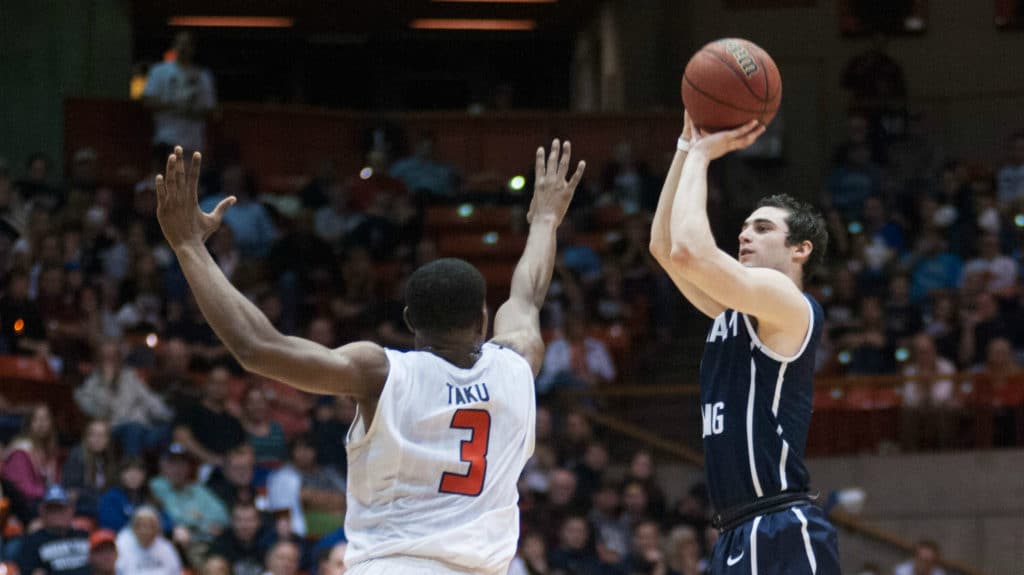
1. Mental Toughness as Shooter
- Confidence
- Has the confidence to take and make shots when open
- Judges themselves on taking a good shot, not whether they made or missed the shot
- Short Memory
- Realizes that the only shot that matters is the next shot
- May miss a few shots in a row, but doesn’t keep you from shooting the next quality shot that comes their way
- Fight Through Fatigue
- Can make shots at the end of the game when tired because they stay mentally engaged and practice great shooting fundamentals
- Desire to Take Big Shots
- Actively looks to take the big shot at the end of a game
- Wants the ball at the end of the game and trusts their shot
2. Basketball Shooting Fundamentals
- Shot Preparation
- Down ready to shoot before the ball gets there
- Comes into their shot the same way every time (muscle memory)
- Great balance and footwork on every shot
- Shooting the Ball
- Catches ball in the shooting pocket with the wrist cocked
- The ball comes straight up the body
- Shoots the ball in one smooth motion
- Uses legs correctly to help improve shooting range
- Follow Through
- Lands in the same area as they jumped from (unless purposely fading away or drifting to get the shot off)
- Hand in the basket until the shot is made or missed
- Doesn’t practice poor habits like kicking a leg out
3. Shot Selection
- Quality of Shot
- Understands the difference between a high and low percentage shot
- Understands personal shooting strengths and weaknesses
- Avoids shooting the shots that they are weak in, i.e., step back, hang dribble, etc. (this list is different for each shooter)
- Trust Teammates
- Is willing to give the ball up early in a possession to get it back later for a better shot
- Heating Up
- Knows when their shot is falling and how to be aggressive when it is
- Knows when an easy shot is needed to get going or to get back on track
4. Basketball Game Flow
- Time and Score
- Understands when the ball needs to be moved around and when it is time for a quick shot
- Momentum Score
- Can make a big shot to answer the other team’s run
- Can make a big shot to put the dagger into the other team
5. Game-Speed Basketball Shooting
- Shooting Drills
- Practices shooting at game speed and is ready for game shots
- Types of Shots
- Works on multiple types of shots
- Doesn’t avoid weaknesses when training
6. Move Without the Ball
- Uses Screens
- Primary Screens: Down screens, back screens, flare screens, ball screens
- Primary Cuts of Screens: Curl cut, pro-cut, straight cut, fade cut
- Hard Cuts
- Reads their defender and then makes the appropriate cut to get open
- Spacing
- Creates a passing lane for the passer by sliding up or down on penetration and post feeds
7. Basketball Conditioning
- Transition
- Beats the defense up the floor for an open shot
- Catch and shoot shot or rip through/shot fake one dribble shot
- Use screens
- Can run a defender ragged off of multiple screens
- Pauses and reads defender before each screen
8. Exploits the Scouting Report Defense
- Penetration
- Can make the defense pay on an over-closeout
- Efficient Use of Dribbles
- Only uses 1-2 dribbles on penetration to get shot off
- Can drive and kick if help defender steps up on penetration
- Shot Fake
- Recognizes scouting report defense and uses Shot Fake to exploit it
- Use the Shot Fake to get past the defender and also to draw fouls
Taking your Basketball Shooting to the Next Level
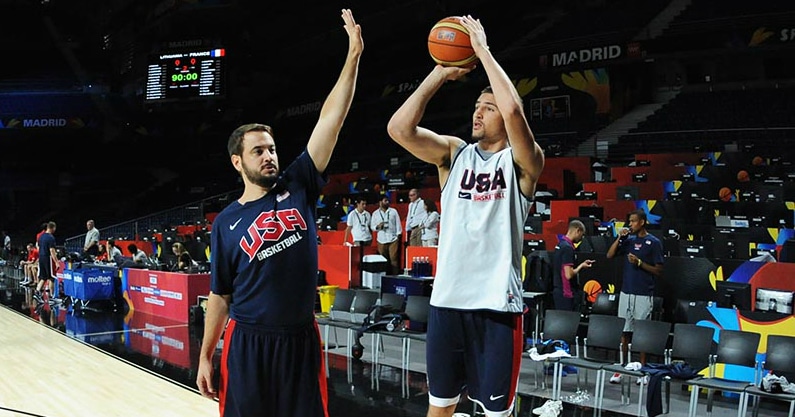
Chris Capko contributed to this portion of the article.
As a player, you should be watching the game of basketball. Whether it is your level, conference, a level up, or a level down, you should be paying attention to how the game is being played. Each level or league generally has its own style and brand of basketball. Some leagues are more physical, while some are more fast-paced. You need to be big in some leagues, and some you can get away with being a little smaller.
One thing that has become more apparent at any level to win in today’s basketball is the ability to shoot the basketball. No matter the position, you become more valuable in today’s game if you can help spread the floor by shooting the basketball. Even if you aren’t deficient as a shooter and it is one of your strengths, you can always develop and improve.
Regardless of whether it is the offseason or in season, you need to improve your shot regularly. Here are some ways that you can take your shooting to the next level.
5 Shooting Concepts
The best shooters in the game have mastered the details of shooting by first spending the time learning the correct shooting techniques and then putting countless hours into turning them into muscle memory. Here are five concepts that you can use to help take your shooting to the next level.
The “L” Drill
Regardless of the shooter, every day starts with the “L” Drill shooting. All we do in this basketball shooting drill is accentuate what I call the “L” in someone’s shot. This is a one-handed shooting drill in which we want to emphasize both follow through and arc. I may have our players make anywhere from 100-150 shots right around the basket. This is repeated EVERY DAY.
Guide Hand on Your Shot
The next thing I will generally do is bring the second hand or “guide” hand into the shot. Again, we will do this from a close distance to ensure that the technique is perfect. I make them hold their form up through the result of the shot. They will make anywhere from 50-100 makes at about 1 step further than “L” shooting.
Footwork When Shooting the Basketball
We will then begin to get our footwork into the shot. We still will stay inside the paint and make sure the top part of their shot is correct. I teach a 1,2 step into every player’s shot. To me, this helps give the player a plan for each shot, as opposed to guessing.
Also, I believe it is an easy transition into a player’s triple threat moves. When doing this, you want to ensure that the player is jumping straight up and down, and his/her momentum is taking them to the basket. Do not let your players start walking backward or fade. The principles that you teach for the top part of your shot should remain intact.
Consistent Repetition When Shooting
Now, regardless of the shooter’s level, I will still go to about 15 feet and shoot at about 5-7 different spots on the floor. I like to give each player a goal at each spot. For instance, if a player is very good at 15 feet, the goal is not to miss two shots in a row.
If he/she misses two in a row, the shooting drill starts over. They must make ten shots without missing two in a row. After completing 10 makes from one spot, I like to go right into consecutive shooting and see how many in a row they can complete.
Basketball drills like this force your players to focus on the mechanics you had worked on before you got to 15 feet and the competitor in them generally comes out. If they miss two-in-a-row, you will usually see them get mad and really lock in to end the drill. If they make 10-in-a-row, you will see them want to make eleven now and so on. I will do the same out to the 3-point-line and off of the dribble shooting as well.
Contested Shots
With better shooters, I will make them make shots with a hand in their face yet maintain the same discipline as if they were five feet away. This isn’t teaching them to take bad shots in a game, but instead to make shots when the clock is running down or if there is a slightly late defensive closeout and just enough time to get a shot off over the defender’s hand.
Closing Thoughts on How to Shoot Better in Basketball
Shooting is more than just physical skills. It takes mental toughness and having confidence in your shot. Great shooters in basketball have the ability to take and make big shots regardless of the pressure. A lot of confidence comes through your time working on your shot in the gym. That being said, there will be nights when you may miss 3 or 4 shots in a row, and you need to have the confidence to step up and make your next open shot. Great basketball shooters have a short memory whether they have made or missed their last shot.
Another big part of learning how to shoot a basketball at a high level is shot selection. If you are shooting low percentage shots, there is a very good chance that you are going to be a poor shooter. You must try to find shots that compliment your game and will be a high percentage shot for you. This means being able to score within the offense and using teammates to help get yourself open.
Great shooters in basketball are not made overnight. It takes learning the right way to shoot and then spending hours in the gym perfecting your craft. If you want to learn how to shoot a basketball and ultimately be a great shooter, you must be willing to get in the gym and spend the time needed.




4 Responses
Thankyou for this great video. Helping me imrove!
Could you guys please do me a huge favor? Could you please stop saying the young man does not dip? If you slow down the video or just watch closely he catches the ball at his chest and brings it down to his waist. It does not slow your shot down. Jeremy Lin has the quickest release in the NBA. Hand he dips.. As does Steph Curry and all of the top shooters currently. College and Pro. Bird, Jordan, Kobe, Kerr, Hodges, Miller… All dip.. That is where your power comes from. Think of Isaac Newton..
Thanks Guys
Michael Dubicki
Could you give any advice on how to make the shot smoother so more range is on the shot?
I completely agree with the importance of proper footwork and balance when shooting. I’ve noticed a big difference in my shooting percentage since I’ve been focusing on these fundamentals. Great post, thanks for sharing!